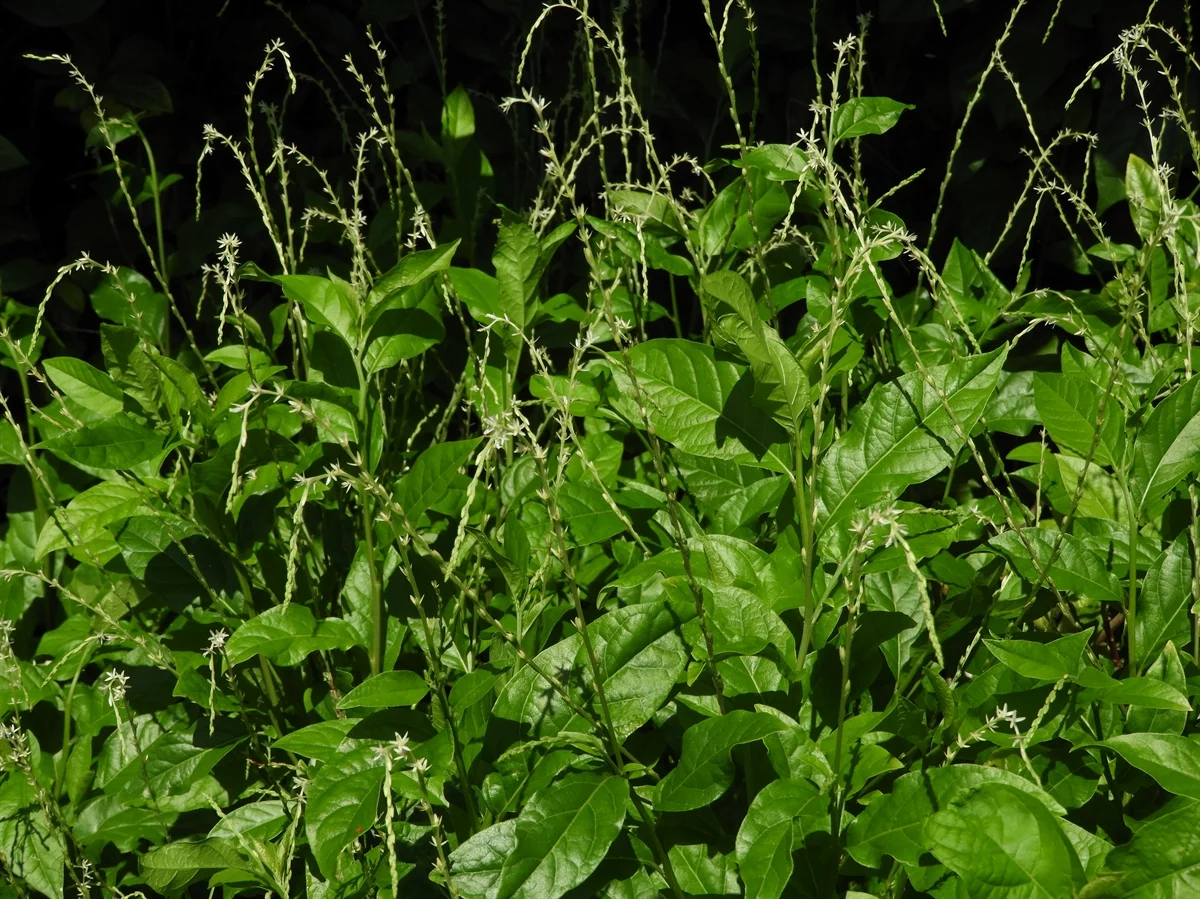Petiveria alliacea

|
|
Petiveria alliacea Common Names: Anamu, Guinea hen weed, Garlic weed,
Root of life Scientific
Classification Kingdom: Plantae Clade: Angiosperms Clade: Eudicots Order: Caryophyllales Family: Phytolaccaceae Genus: Petiveria Species: P. alliacea Synonyms: Petiveria foetida Salisb., Petiveria hexandria Sessé & Moc., Petiveria octandra L. Morphological Description Petiveria alliacea is a perennial herbaceous shrub growing to heights of
0.5–1.5 m. It is characterized by: · Stem: Erect, cylindrical, and branched, with a woody base · Leaves: Alternate, lanceolate to oblong-elliptic (5–15 cm × 2–5 cm),
acuminate apex, entire margins, emitting a pungent garlic-like odor when
crushed due to sulfur-containing compounds · Flowers: Small, white to greenish-white, arranged in terminal or
axillary racemes (5–20 cm long), with 4 tepals and 8 stamens · Fruit: Oblong achene (5–8 mm), with hooked spines aiding dispersal,
containing a single seed Distribution and Habitat Petiveria alliacea is widely distributed across tropical and subtropical
regions, thriving in: · Central and South America: From Mexico to Argentina, abundant in the
Amazon rainforest (altitude 0–1,000 m) · Caribbean: Common in Jamaica, Cuba, and Trinidad, often in disturbed
coastal areas · Africa: Introduced to West Africa (e.g., Nigeria, Ghana), growing in
savannas and forest edges · Southeastern USA: Found in Florida and Texas, typically in
sandy or loamy soils It prefers full sun to
partial shade, tolerating a range of soils (pH 5.5–7.5) and rainfall (800–2,000
mm annually), often colonizing roadsides, pastures, and cultivated fields
(Conceição et al., 2023). Ethnopharmacology Petiveria alliacea commonly known as anamu, is a perennial herb native to the Amazon
rainforest and other tropical regions. It has been traditionally employed in
various cultures for its medicinal properties. The roots and leaves have been
used as antispasmodic, sedative, diuretic, and antihelminthic agents. In
Brazilian folk medicine, it serves as an antispasmodic, diuretic, menstrual
promoter, and stimulant. Additionally, the plant has been utilized to treat
infections, headaches, fever, and colds. Scientific studies have explored its
anti-inflammatory and analgesic effects. Furthermore, P. alliacea has been used in traditional medicine for the treatment
of various central nervous system disorders, such as anxiety, pain, memory
deficits, and seizures. These therapeutic effects are attributed to its rich
phytochemical composition, including sulfur-containing compounds like dibenzyl
trisulfide, flavonoids, and other bioactive constituents. While these findings
support the traditional uses of Petiveria alliacea, further research is
necessary to fully validate its medicinal properties and establish standardized
therapeutic applications · Anti-inflammatory and Analgesic: In Brazil and the Caribbean, leaf
infusions treat rheumatism and muscle pain. A crude root extract reduced
neutrophil migration by 60% and eosinophil counts by 45% in rat pleurisy models
(Lopes-Martins et al., 2002). · Antimicrobial: Used in Jamaican folk medicine for infections, its sulfur
compounds (e.g., dibenzyl trisulfide) inhibit Staphylococcus aureus (MIC 8 μg/mL) and Candida albicans (MIC 16 μg/mL) (Kim et al., 2006). · Anticancer: In Colombian traditions, leaf decoctions are used for
leukemia and breast cancer. Extracts induced 55% tumor reduction in 4T1 breast
cancer murine models (Hernández et al., 2014). · Immunomodulatory: Cuban herbalists use it to boost immunity.
Aqueous fractions increased IL-6 and TNF-α secretion by 30–40% in human
dendritic cells (Santander et al., 2012). · Hypoglycemic: In Trinidad, root teas manage diabetes. Ethanolic extracts
lowered blood glucose by 25% in STZ-induced diabetic rats at 180 mg/kg (Gunawan
et al., 2020). · Neuropharmacological: Known as "tipi" in South
America, it treats anxiety and seizures. Root fractions reduced convulsion
latency by 50% in PTZ-induced mice models (Gomes et al., 2008). ⚠ Toxicity Profile: High doses (>2,000 mg/kg) of leaf/stem powder
showed no acute toxicity (LD₅₀ > 2,000 mg/kg) in rats, but abortifacient
effects were noted in traditional use, contraindicating it during pregnancy.
Chronic use may elevate leukocyte counts due to immunomodulation
(García-González et al., 2018). Phytochemistry The plant’s bioactivity
stems from a diverse chemical profile: · Sulfur Compounds: Dibenzyl disulfide (0.05–0.1% dry weight),
dibenzyl trisulfide (0.02–0.08%), and thiosulfinates, responsible for
antimicrobial and anticancer effects · Flavonoids: Astilbin and myricetin (0.5–1%), contributing to antioxidant
and anti-inflammatory properties · Triterpenes and Steroids: β-sitosterol and stigmasterol, linked to
hypoglycemic activity · Other: Coumarins, tannins, and essential oils (e.g., benzyl alcohol),
enhancing its medicinal versatility (Silva et al., 2018) Additional Uses · Traditional: Diuretic (leaf tea increases urine output by 20%),
antispasmodic (reduces muscle spasms in folk use), and febrifuge (lowers fever
in Cuban remedies) · Cultural: Used in Afro-Brazilian rituals to ward off evil spirits due
to its pungent aroma · Agriculture: Repels insects when planted near crops; crushed leaves deter
pests References
External Links More Pictures |
|
| Compounds of Petiveria alliacea |
|
| References |